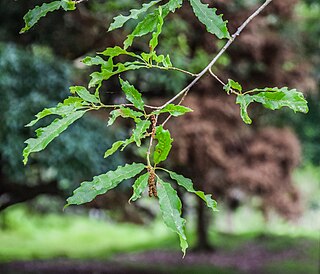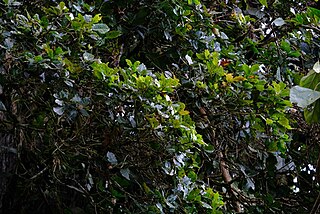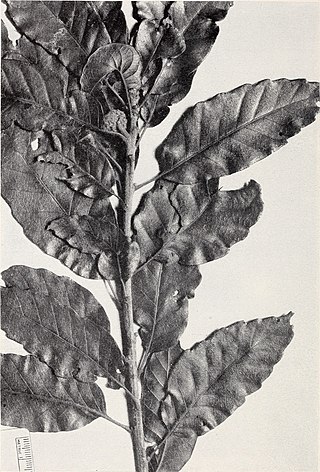
The fiery-throated hummingbird is a species of hummingbird in the "mountain gems" tribe Lampornithini in subfamily Trochilinae. It is found in Costa Rica and Panama.

The Cordillera de Talamanca is a mountain range that lies in the southeast half of Costa Rica and the far west of Panama. Much of the range and the area around it is included in La Amistad International Park, which also is shared between the two countries.

Quercus lancifolia is a species of oak found in Central America and Mexico.

The Talamancan montane forests ecoregion, in the tropical moist broadleaf forest biome, are in montane Costa Rica and western Panama in Central America.

The Costa Rican páramo, also known as the Talamanca páramo, is a natural region of montane grassland and shrubland of Costa Rica and western Panama.

Quercus copeyensis is a species of oak endemic to the Talamancan montane forests of Costa Rica and Panama. It is commonly called Panamanian oak.

Dice's cottontail is a species of cottontail rabbit in the family Leporidae. It is found in Costa Rica and Panama, in páramo and cloud forest habitats.
Magnolia panamensis is a species of flowering plant in the family Magnoliaceae. It is native to Panama, and its distribution probably extends into Costa Rica. It is a forest tree with few current threats to its populations.
Sciodaphyllum chartaceum is a species of plant in the family Araliaceae. It is found in Costa Rica and Panama. It is threatened by habitat loss.
Sciodaphyllum seibertii is a species of plant in the family Araliaceae. It is a shrub or small tree native to Costa Rica and western Panama.
Ficus crassiuscula is a species of flowering plant in the family Moraceae, native to Central America and north-western parts of South America.
Magnolia poasana is a sub-tropical to tropical, subcanopy tree, growing in areas of montane rainforest. The names "Poas", and "poasana" originate from the Poás Volcano in Costa Rica where, along with Panama, they grow in the wild. First described by Henri François Pittier in 1910, it was later described and included in Magnolia by James Edgar Dandy (1927).

Werauhia williamsii is a species of flowering plant in the genus Werauhia. It is a terrestrial bromeliad, native the montane forests of Costa Rica and western Panama.

The Luzon rain forests is a tropical moist broadleaf forest ecoregion on the island of Luzon. Luzon is the largest island in the Philippines, and the Luzon rain forests is the most extensive rainforest ecoregion of the country. The ecoregion includes the lowlands of Luzon and neighboring islands below 1000 meters elevation. Very little of the original rainforest remains, and the status of this area is critical/endangered.

Quercus corrugata is a species of oak found in Central America and Mexico.

Brunellia comocladifolia, commonly known as the West Indian sumac, is a species of tree in the family Brunelliaceae. It is native to Central America, the West Indies, and northern South America.
Sciodaphyllum albocapitatum is a flowering plant in the family Araliaceae. It is a small tree, which grows 5 to 10 meters tall. It flowers in June.

Quercus cortesii is a species of oak native to Central America and southern Mexico.

Cornus disciflora is a species of flowering plant native to Mexico and Central America.
Magnolia sororum is a species of flowering plant in the family Magnoliaceae. It is commonly known as vaco. It is native to the mountain forests of Costa Rica and western Panama, and may range into Nicaragua.














